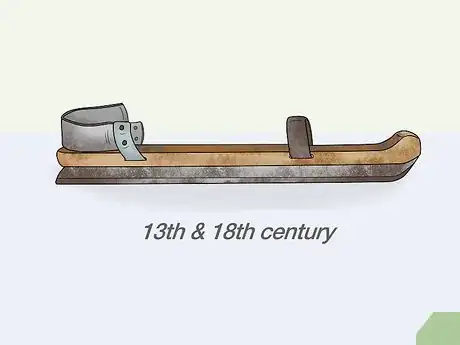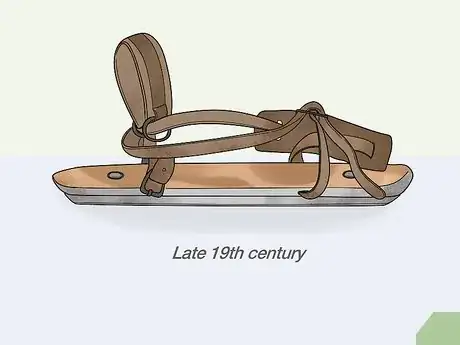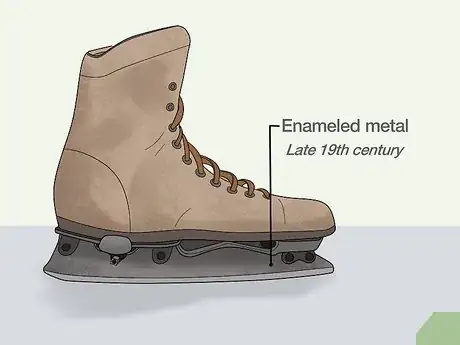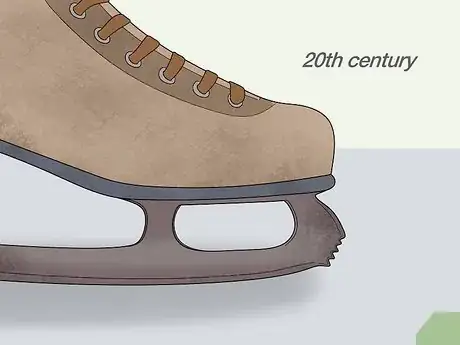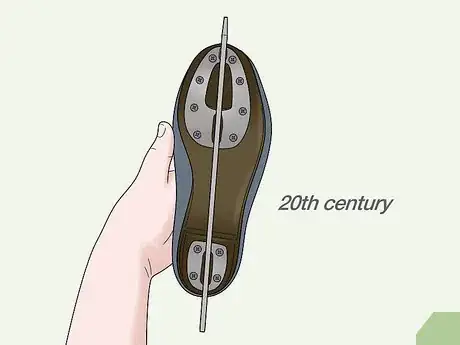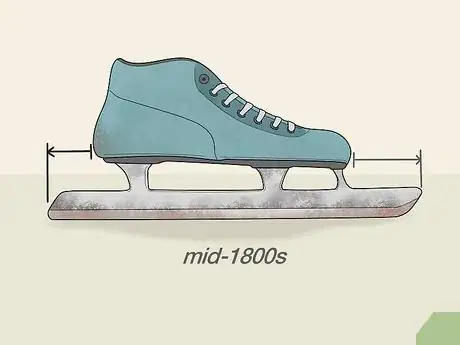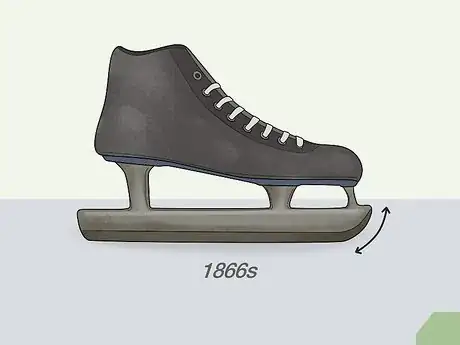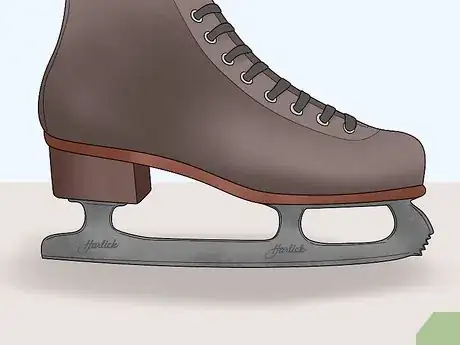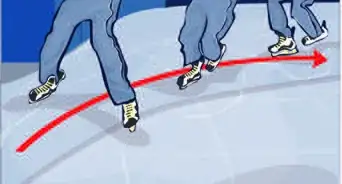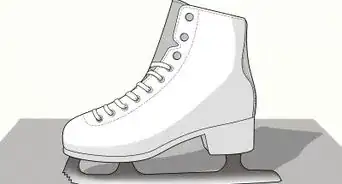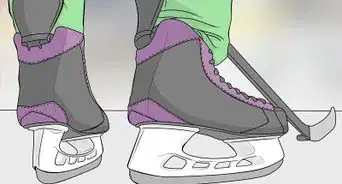This article was co-authored by wikiHow staff writer, Janice Tieperman. Janice is a professional and creative writer who has worked at wikiHow since 2019. With both a B.A. and M.A. in English from East Stroudsburg University, she has a passion for writing a wide variety of content for anyone and everyone. In her free time, you can find her working on a new crochet pattern, listening to true crime podcasts, or tackling a new creative writing project.
This article has been viewed 13,555 times.
Learn more...
As ice skating has grown and developed as an activity and sport over thousands of years, ice skates themselves have transformed and evolved in both structure and style. If you've stumbled across a pair of antique or vintage skates, you may want to know how old they are before adding them to your personal collection. While it’s best to consult a professional to appraise these relics, you can roughly estimate the age of your skates by carefully studying the materials used to make them, as well as the style of the skate itself.
Steps
Studying the Materials
-
1Note that skates made with animal bone could date back thousands of years. Check the blade of your skate to see if it’s constructed from a large animal bone, like a deer, horse, or ox. Additionally, see if the bone has leather straps or laces that are drilled or otherwise attached to the skate itself. Note that these skates won’t be very sharp, and are more used for coasting along the ice. Unfortunately, there’s no exact way to date this type of equipment; however, you can assume that skates were created BCE.[1]
- Animal bone skates tend to be off-white or slightly yellow in color.[2]
- Traditionally, settlers would use a stick or pole to provide direction and stability on the ice, as the bone skates couldn’t be used on their own.
- Since these skates are very old, it’s unlikely that you’ll stumble across them anywhere.
-
2Place wooden skates with a metal blade between the 13th and 18th century. Examine the base of your skate and see if it resembles a block of wood. Similar to prehistoric equipment, wooden skates had leather laces or straps attached to the base, with the addition of a metal blade secured to the bottom of the wood. While there’s no way to date them exactly, you can assume that wooden skates were constructed somewhere between the 13th and 18th century, before metal and cloth were more commonly used.[3]
- Some wooden skates have a curved edge along the toe, which means they were crafted after the 15th century.
- Since these skates pre-date the 19th century, you probably won’t come across any in your search for antiques.
Advertisement -
3Date skates with leathers straps and wooden soles to the late 19th century. Examine the base of your skates to see how the soles were constructed. Note that skates made around the end of the 19th century and the turn of the 20th century tended to be fashioned with wood instead of metal. Toward the heel of the skate, look for a visible screw or screwhole that would’ve connected the skate to a person’s boot.[4]
- Older skates weren’t designed as individual shoes. Instead, they were extensions that the skater attached to their boot.
-
4Associate enameled metal skates with the late 19th century. Examine the metal surface of your antique skate to see if it has a glaze or enamel overtop. While the enamel coating won’t look as sleek and smooth as it did when it was first crafted, it should still be present on the surface of the steel.[5]
- Enameled metal skates were attachments that the skater could fit their boot or shoe into.
-
5Identify metal toe picks as a 20th century innovation. Look along the tip of the skate to see if the curve of the blade is barbed or smooth. If a barb is present on the skate, note that this portion is known as a toe pick, which helped modern skaters begin to perform jumps while figure skating.[6]
- Since toe picks were designed for more expressive skating, they weren’t necessary or included in older skates.
-
6Note that skates with screwed-in blades are from the 20th century. If your skates roughly resemble a modern figure or hockey skate, note that the footwear was likely made within the last century or so. Flip over the skate to look at the bottom of the boot, and see if there are screws connecting the blade to the rest of the shoe. If so, you can date your boot to some point in the 1900s.[7]
Examining Different Skate Styles
-
1Note that antique racing skates were made after the mid-1800s. Check the bottom of your skate to see if the blade is straight, even, and much longer than the base of the skate itself. If so, you can safely assume that you have a racing skate instead of a traditional figure or hockey skate. Since these skates weren’t modernized until the mid-1800s, you can assume that your skates were made sometime after.[8]
-
2Date hockey skates to 1866 or sooner. Check the base of your hockey skates to examine the blade. See if the blade has a steep curve, or if the blade is straight and even along the base of the skate. If the blade is curved along the front half, your skate was probably designed for hockey.[9]
- Original hockey skates were composed of a short boot. It wasn’t until the 1890s that support straps were added to the skates.
-
3Associate metal clamp skates with the late 19th century. Feel along the base of your skating boot to see what it’s made with. If the soles and rims of the skate are strapless and made entirely out of metal, you can assume that they’re clamp skates. Many of these skates were created between the 1870s and 1890s, so you can date them to that specific era.[10]
- As the nickname suggests, these skates had clipping or “clamping” attachments that would connect them to the skater’s boot.
-
4Note that strap-on skates were made in the early 20th century or prior. Examine the base of the skate to see if it uses leather straps, buckles, or screws to connect with the skater’s boot. If you see these mechanisms, you can safely assume that your skate was made in the late 1800s or early 1900s, or possibly before then. If your skate uses leather laces instead of straps or screws, it might date back to the 1200s through the 1700s.[11]
- Leather laces are associated with very old skates, while buckles, straps, and screws are more modern innovations.
-
5Check the metalwork for any sign of a brand or label. If you suspect that your boots were made in the 20th century, check along the blade to see if there’s a logo emblazoned onto the skate. If you spot any distinctive logo or feature on the skate, search it online to see if the company still exists, and when they specifically operated.[12]
- For instance, if your skate has the “Harlick” logo on it, you can assume that they were made sometime after 1935.
References
- ↑ https://www.wimuseum.org/pair-of-antique-ice-skates/
- ↑ https://www.sciencefriday.com/articles/history-ice-skates/
- ↑ https://www.sciencefriday.com/articles/history-ice-skates/
- ↑ https://www.wimuseum.org/pair-of-antique-ice-skates/
- ↑ https://www.vintagewinter.com/collections/antique-ice-skates
- ↑ https://www.sciencefriday.com/articles/history-ice-skates/
- ↑ https://www.sciencefriday.com/articles/history-ice-skates/
- ↑ https://www.britannica.com/sports/speed-skating
- ↑ https://www.sportsrec.com/5050319/figure-skates-vs-hockey-skates

